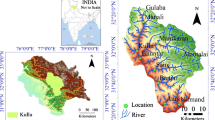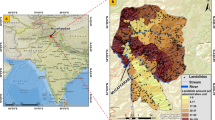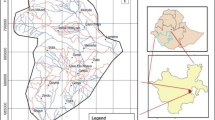Abstract
Landslide risk assessment methods can be carried out at the regional or site scales. In the present study, logistic regression method (a quantitative method) and the fuzzy sets theory (a semi-quantitative method) have been used for landslide hazard and risk assessment, respectively, at a regional scale. The hazard potential and resource damage potential have been obtained from the hazard zonation and the land cover / land use maps. The landslides occurrence probability has been estimated based on the causal factors responsible for slope destabilization, in a specified period of time. At this stage, 75 % of the pixels with landslide have been entered to the model as the estimation group, in which new landslides have occurred with a moderate to high intensity or at least have displaced once or more in the past 50 years. The accuracy of the results from the statistical estimation of landslide occurrence probability have been evaluated and validated based on 25 % of the remaining landslide pixels. Landslide hazard assessment representing the accuracy of prediction model is 83.2 %. The risk zonation was performed by combination of the hazard potential and resource damage potential and using the fuzzy algebraic product operator in the region. Results show that 62.9 % of the area is placed in low and very low risk categories and 19.5 % of the rangeland areas are located in class of high risk zone. Proposed method was used for landslide risk assessment in Hashtchin region (in the northwest of Iran), and obtained results can be used in the land use planning, developmental activities and implementation of building.




Similar content being viewed by others
References
Ansari F, Blurchi MC (1996) Landslides of Ardabile province, Iran. Ministry of Industry and Mines, Geological survey of Iran, Iran (in Persian)
Ayalew L, Yamagishi H (2005) The application of GIS-based logistic regression for landslide susceptibility mapping in the Kakuda-Yahiko mountains, central Japan. Geomorphology 65:15–31
Ayalew L, Yamagishi H, Marui H, Kanno T (2005) Landslides in Sado Island of Japan: Part II. GIS-based susceptibility mapping with comparisons of results from two methods and verifications. Eng Geol 81:432–445
Bergerud WA (1996) Introduction to logistic regression models, with worked forestry examples. Biometrics information handbook. Ministry of forests research program, Forestry Division Services Branch, Victoria
Bernknopf RL, Campbell RH, Brookshire DS, Shapiro CD (1988) A probabilistic approach to landslide hazard mapping in Cincinnati, Ohio, with applications for economic evaluation. Bull Assoc Eng Geol 25:39–56
Boggett AD, Mapplebeck NJ, Cullen RJ (2000) South shore cliffs, whitehaven-geomorphological survey and emergency cliff stabilization works. Q J Eng Geol Hydrogeol 33:213–226
Cardinali M, Reichenbach P, Guzzetti F, Ardizzone F, Antonini G, Galli M, Cacciano M, Castellani M, Salvati P (2002) A geomorphological approach to estimate landslide hazard and risk in urban and rural areas in Umbria, central Italy. Nat Hazards Earth Syst Sci 2(1–2):57–72
Carrara A, Cardinali M, Detti R, Guzzetti F, Pasqui V, Reichenbach P (1991) GIS techniques and statistical models in evaluating landslide hazard. Earth Surf Proc Land 16:427–445
Chang KT, Chiang SH, Hsu ML (2007) Modeling typhoon—and earthquake—induced landslides in a mountainous watershed using logistic regression. Geomorphology 89(3–4):335–347
Chi KH, Park NW, Chung CJ (2002) Fuzzy logic integration for landslide hazard mapping using spatial data from Boeun, Korea. Symposium on geospatial theory, Processing and applications, Ottawa, 8–12 July 2002
Chung CF, Fabbri AG (2001) Prediction models for landslide hazard zonation using a fuzzy set approach. In: Rivas V, Marchetti M (eds) Geomorphology and environmental impact assessment. Balkema Publishers, Rotterdam, pp 31–47
Cox DR, Snell EJ (1989) The analysis of binary data, 2nd edn. Chapman and Hall, London
Crozier MJ, Glade T (2005) Landslide hazard and risk: issues, concepts and approach. In: Glade T, Anderson MG, Crozier MJ (eds) Landslide hazard and risk. John Wiley and Sons Ltd, England, pp 1–40
Dai FC, Lee CF (2002) Landslide characteristics and slope instability modeling using GIS Lantau Island, Hong Kong. Geomorphology 42:213–228
Dai FC, Lee CF, Li J, Xu ZW (2001) Assessment of landslide susceptibility on the natural terrain of Lantau Island, Hong Kong. Environ Geol 40(3):381–391
Dai FC, Lee CF, Ngai YY (2002) Landslide risk assessment and management: an overview. Eng Geol 64(1):65–87
Davies RG, Jones CR, Hamzepour B, Clark GC (1972) The geology of the Masuleh sheet (northwest Iran). Ministry of Industry and Mines, Geological Survey of Iran, No 24
Davies RG, Clark GC, Hamzepour B, Jones CR (1975) Explanatory text of the Bandar-e-Pahlavi quadrangle map, 1:250000. Ministry of Industry and Mines, Geological Survey of Iran, No D3
Dong JJ, Tung YH, Chen CC, Liao JJ, Pan YW (2011) Logistic regression model for predicting the failure probability of a landslide dam. Eng Geol 117:52–61
Duman TY, Can T, Gokceoglu C, Nefeslioglu HA, Sonmez H (2006) Application of logistic regression for landslide susceptibility zoning of Cekmece Area, Istanbul, Turkey. Environ Geol 51:241–256
Düzgün HSB, Özdemir A (2006) Landslide risk assessment and management by decision analytical procedure for Dereköyç Konyaç Turkey. Nat Hazards 39:245–263
Dykes AP (2002) Weathering-limited rainfall-triggered shallow massmovements in undisturbed steepland tropical rainforest. Geomorphology 46:73–93
Faridi M, Anvari A (1996) Geological map of the Hashtchin area, 1:100000. Ministry of Industry and Mines, Geological Survey of Iran, No 5664
Glade T, Crozier M (2005) A review of scale dependency in landslide hazard and risk analysis. In: Glade T, Anderson MG, Crozier MJ (eds) Landslide hazard and risk. John Wiley and Sons Ltd, England, pp 75–138
Greco R, Sorriso-Valvo M, Catalano E (2007) Logistic regression analysis in the evaluation of mass movements susceptibility, case study, Calabria, Italy. Eng Geol 89(1–2):47–66
Grozavu A, Mărgărint MC, Patriche CV (2012) Landslide susceptibility assessment in the brăieşti-sineşti sector of iaşi cuesta. Carpathian J Earth Environ Sci 5(2):61–70
Guzzetti F (2000) Landslide fatalities and the evaluation of landslide risk in Italy. Eng Geol 58:89–107
Guzzetti F (2002) Landslide hazard assessment and risk evaluation: limits and prospective. Mediterranean Storms, Proceedings of the 4th EGS Plinius conference held at Mallorca, Spain, 2002
Hashemi Tabatabaei S (1998) Landslide hazard zonation in southwest of Ardabil Province Iran. Ministry of Roads and Urban Development, Tehran (in Persian)
Hemmati R, Dolatimehr A, Nasirifaər A, Shahbazi M, Hezhabrpour Gh, Aghaei Kh (2007) Ardabil Province climate. Applied Meteorology research center of Ardabil, Islamic Republication of Iran, Meteorological Organization, Ministry of Roads and Urban Development, Iran (in Persian)
Kanungo DP, Arora MK, Gupta RP, Sarkar S (2008) Landslide risk assessment using concepts of danger pixels and fuzzy set theory in Darjeeling Himalayas. Landslides 5:407–416
Kleinbaum DG, Klein M (2010) Logistic regression: a self-learning text, 3rd edn. Springer, New York
Kong WK (2002) Risk assessment of slopes. Quart J Eng Geol Hydrogeol 35:213–222
Lee EM (1999) Coastal planning and management: the impact of the 1993 Holbeck Hall Landslide, Scarborough, east Midlands. Geographer 21:78–91
Lee EM, Clark AR (2000) The use of archive records in landslide risk assessment: historical landslide events on the Scarborough Coast, UK. In: Bromhead EN, Dixon N, Ibsen ML (eds) Landslides: in research, theory and practice. Thomas Telford, London, pp 904–910
Lee S (2004) Application of likelihood ratio and logistic regression models to landslide susceptibility mapping using GIS. Environ Manage 34(2):223–232
Liu X, Lei J (2003) A method for assessing regional debris flow risk: an application in Zhaotong of Yunnan province (SW China). Geomorphology 52:181–191
Mahdavifar MR (1996) Landslide hazard zonation in Khorshrostam region (southwest of Khalkhal County). Dissertation, Tarbiat Modarres University, Tehran
Mathew J, Jha VK, Rawat GS (2009) Landslide susceptibility zonation mapping and its validation in part of Garhwal Lesser Himalaya, India, using binary logistic regression analysis and receiver operating characteristic curve method. Landslides 6:17–26
Mejía-Navarro M, Wohl EE, Oaks SD (1994) Geological hazard, vulnerability, and risk assessment using GIS: model for Glenwood Springs, Colorado. Geomorphology 10:331–354
Menard S (2002) Applied logistic regression analysis, 2nd edn. Sage University paper series on quantitative applications in social sciences, Thousand Oaks
Nagelkerke NJD (1991) A note on a general definition of the coefficient of determination. Biometrika 78:691–692
Nikandish N, Mir Sanei R (1996) Introduction to Ardabile Province landslides. Iran Ministry of Agriculture, Tehran (in Persian)
Ohlmacher CG, Davis CJ (2003) Using multiple regression and GIS technology to predict landslide hazard in northeast Kansas, USA. Eng. Geol. 69:331–343
Pallant J (2007) A step-by-step guide to data analysis using SPSS version 15, SPSS, survival manual, 3rd edn. McGraw-Hill, Sydney
Peng CY, Lee K, Ingersoll GM (2002) An introduction to logistic regression analysis and reporting. J Educ Res 96(1):3–14
Sdao F, Lioi DS, Pascale S, Caniani D, Mancini IM (2013) Landslide susceptibility assessment by using a neuro-fuzzy model: a case study in the Rupestrian heritage rich area of Matera. Nat Hazards Earth Syst Sci 13:395–407
Shoaei et al (2005) Interpretation of the mechanism of motion and suggestion of remedial measures using GPS continuous monitoring data. Landslides: Risk analysis and sustainable disaster management. Proceeding of the first general assembly of the international consortium of landslides. Springer-Verlag, Berlin, Germany, pp 327–335
Shou KJ, Chen YL (2005) Spatial risk analysis of Li-shan landslide in Taiwan. Eng Geol 80:199–213
Swets JA (1988) Measuring the accuracy of diagnostic systems. Science 240:1285–1293
Talaei R (2012) Determination and assessment of landslide hazard index in the Hashtjin area (northwestern region of Iran). Bulletin of the Moscow State Regional University, Series “Natural Sciences” 1:69–74
Talaei R, Ghayoumian J, Shariat Jafari M, Aliakbarzadeh E (2004) Study on effective factor causing landslide in southwest of Khalkhal region. Agricultral Research, Education and Extension Organization, Soil Conservation and Watershed Management Institute, Tehran (in Persian)
Uromeihy A, Mahdavifar MR (2000) Landslide hazard zonation of the Khorshrostam area, Iran. Bull Eng Geol Environ 58:207–213
van Erkel AR, Pattynama PMTh (1998) Receiver operating characteristic (ROC) analysis: basic principles and applications in radiology. Eur J Radiol 27:88–94
van Westen CJ, van Asch TWJ, Soeters R (2005) Landslide hazard and risk zonation—why is it still so difficult? Bull Eng Geol Environ 65:176–184
Varnes DJ (1984) Landslide hazard zonation: A review of principles and practice. IAEG Commission on landslides and other mass movements. UNESCO Press, Paris
Wang HB, Sassa K (2005) Comparative evaluation of landslide susceptibility in Minamata area, Japan. Environ Geol 47:956–966
Yesilnacar E, Topal T (2005) Landslide susceptibility mapping: A comparison of logistic regression and neural networks methods in a medium scale study, Hendek region (Turkey). Eng Geol 79(3–4):251–261
Yoshimatsu H, Abe S (2006) A review of landslide hazards in Japan and assessment of their susceptibility using an analytical hierarchic process (AHP) method. Landslides 3:149–158
Zadeh LA (1965) Fuzzy sets. Inf Control 8:338–353
Zêzere JL, Oliveira SC, Garcia RAC, Reis E (2007) Landslide risk analysis in the area North of Lisbon (Portugal): evaluation of direct and indirect costs resulting from a motorway disruption by slope movements. Landslides 4:123–136
Zweig MH, Campbell G (1993) Receiver operating characteristic (roc) plots: A fundamental evaluation tool in clinical medicine. Clin Chem 39(4):561–577
Author information
Authors and Affiliations
Corresponding author
Rights and permissions
About this article
Cite this article
Talaei, R. Landslide risk assessment using a multi-method approach in Hashtchin region (NW of Iran). Acta Geod Geophys 49, 381–401 (2014). https://doi.org/10.1007/s40328-014-0052-x
Received:
Accepted:
Published:
Issue Date:
DOI: https://doi.org/10.1007/s40328-014-0052-x




